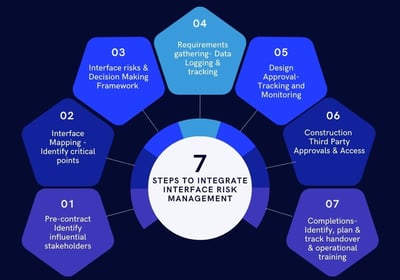Services Offering
Enhancing communication and managing risks for complex projects through expert strategies and training.
Communication Assessment
Communication assessment in Interface Management evaluates the effectiveness of information flow between project stakeholders. It ensures clarity, alignment, and timely resolution of interface issues, minimizing misunderstandings and delays. Strong communication strategies enhance collaboration, reducing risks to project success.


Risk Assessment & Mitigation
Project team training ensures alignment on goals, roles, and responsibilities, fostering a shared understanding of project objectives. Targeted training enhances collaboration, improves decision-making, and strengthens Interface Management processes. Well-trained teams minimize risks, streamline workflows, and drive project success.
Team Alignment










Third Party Approvals and Management
Interface mapping starts with definition and ranking. This involves categorizing interfaces by type, such as technical, organizational, or contractual, to ensure clear project alignment. This process includes stakeholder identification, assessing their decision rights, interest, and influence to develop an effective engagement and management strategy. Additionally, interface schedule planning and coordination are essential for seamless project execution, minimizing delays and conflicts. A structured approach to stakeholder conflict management helps address potential disputes proactively. Finally, planning and implementing software solutions support efficient interface tracking, communication, and overall project integration.
Risk mitigation in Interface Management involves proactively identifying, assessing, and managing interdependencies between project elements. Clear communication, structured coordination, and real-time monitoring help prevent conflicts and delays. Effective Interface Management ensures seamless integration, reducing risks to cost, schedule, and project outcomes.
Decision-making in large infrastructure projects is inherently complex due to the involvement of multiple stakeholders, competing interests, and the high-risk nature of these projects. To ensure structured and effective decision-making, project teams utilize various frameworks that align stakeholders and integrate Interface Management (IM) as a key component.
Interface Mapping and Strategy
Decision Making Frameworks
Third-party approvals for major Australian projects involve regulatory, environmental, heritage, and utility consents. Key approvals include environmental impact assessments, native title clearances, and transport permits. Effective stakeholder coordination and Interface Management help streamline the process, ensuring compliance and minimizing delays.
Enhancing project communication and managing interface risks.
Contact
Rob Miraglia: +61 414 348 101 Jonathan Hesselberg: +61 415 779 661
© 2025. All rights reserved.
